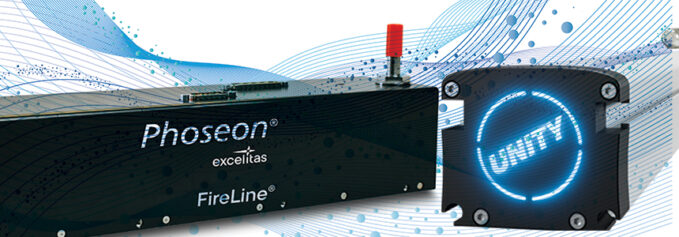
by Cassandra Balentine
Air- and water-based cooling systems are available to decrease the temperature of UV lamps used in industrial printing environments.
Above: The Excelitas FireLine FL400 UV LED Area Curing System is designed for the most challenging industrial printing environments and now features enhanced performance.
While both air- and water-cooled systems utilize the same core curing technology, emitting energy through light emitting diodes (LEDs), Robert Waddington, product line leader, curing and drying, BW Converting, explains that the distinction lies in how each system manages heat.
“Air-cooled systems rely on airflow, typically through internal fans or external blowers, to maintain operational temperature. Water-cooled systems use a liquid coolant, which provides a more controlled and consistent thermal environment. In digital printing applications where footprint, performance, and thermal stability are key, this difference can influence system choice and output quality depending on the press architecture and application demands,” says Waddington.
Differentiating Factors
In water- and air-cooled UV LED curing systems, the LEDs are the same. However, Meredith Stines, president, American Ultraviolet, explains that the LEDs produce a lot of heat off the back side of the module, which needs to get exhausted and lowered to prolong the life of the LED.
Air-cooled systems allow for easy and cost-effective integration into automated systems without the need for a separate chiller. “They are designed to be versatile and can be used for high-performance pinning and full curing in digital printing applications,” says Stacy Hoge, marketing manager, Excelitas.
Air-cooled systems have made significant progress with the use of forced-air designs that leverage advanced fans and heat sinks. “These systems can now support medium- to high-power levels suitable for many digital printing applications, although they may not match the top-end performance or long duration thermal stability of water-cooled units,” offers Ken Reynolds, director of strategic marketing, ProPhotonix, an Exaktera Company.
From an environmental perspective, air-cooled systems can introduce dust and debris into the system if filters are not maintained and tend to generate noise due to fan operation, adds Reynolds.
Reynolds also cautions that heat is released into the surrounding environment in air-cooled systems, which may affect ambient temperatures and HVAC load.
Mark VandenBosch, technical sales, IST America, suggests that while air-cooled systems are well suited to narrow width applications, water-cooled systems become the preferred option as application width and volume increases. “Water-cooled LEDs enable significantly higher output performance, supporting faster line speeds and more demanding industrial use cases.”
Another advantage of water cooling is a simplified facility infrastructure, there’s no need to penetrate the outside for ducting or managing of ozone byproducts. “If heat is effectively removed through water, exhaust systems become virtually unnecessary. As more digital printing systems now incorporate water circuits for chill rollers, the adoption of water-cooled LED technology is poised to grow in the digital sector,” explains VandenBosch.
In terms of intensity, Reynolds feels that water cooling allows for higher sustained output levels, making it ideal for high speed or high-throughput industrial printing applications that demand consistent, intense UV curing or high-lumen performance.
Water-cooled systems provide smaller form factors and tend to have higher peak irradiance. “Water-cooled systems are designed to be rugged and reliable to succeed in the toughest customer environments for industrial printing applications with extreme temperatures and debris,” comments Hoge.
According to Reynolds, water-cooled systems are more compact at the point of heat generation, as water’s superior thermal conductivity allows for smaller LED modules or lamp heads while still handling high power loads. “However, this comes with the trade-off of needing external infrastructure, such as chillers, tubing, and pumps, which can increase overall system size and complexity.”
Stines agrees, noting that water-cooled systems require a chiller for the water to recirculate behind the LED chips’ heat sink.
Water-cooled systems are sealed, reducing dust concerns; and tend to be quieter at the point of use, although the chiller itself can produce noise and consumes additional power. “Heat is removed more efficiently from the system, helping to maintain better thermal stability in the print zone,” comments Reynolds.
Evolution of UV LED
As we discuss the cooling components of industrial UV and UV LED printing, it is important to highlight the overarching technology evolutions.
UV LED curing has advanced over the past decade, transforming from a niche technology into a mainstream solution for industrial and digital printing, packaging, and manufacturing. “This progress is driven by three key factors—improvements in LED efficiency and availability, reductions in cost, and advancements in lamp power output,” shares Reynolds.
VandenBosch feels that UV LED curing follows the classic trajectory of technological evolution—as adoption has increased, so have performance and affordability. “Earlier generations were costlier and had limited capabilities. Now, with more refined chip sets, optics, and thermal management, UV LED systems deliver high performance with improved efficiency and ease of integration. The increased reliability and reduced complexity make LED curing more accessible across an array of applications, including industrial and digital print sectors.”
Waddington notes significant advancements in efficiency, flexibility, and application scope. “Early-generation systems were limited in power and wavelength range, but today’s platforms offer broader spectral capabilities with emerging advancements in UVB and UVC. These improvements have enabled longer lifespans often exceeding 40,000 hours, lower energy consumption, and more precise curing, especially on heat-sensitive or regulatory-compliant substrates. As manufacturing processes and semiconductor materials evolve, UV LED systems are now suited for increasingly demanding industrial applications that were once the sole domain of arc technology.”
Early UV LED systems were limited in both availability and performance, but improvements in LED chip efficiency—delivering more UV output per watt—make curing systems far more capable and compact. “At the same time, the global expansion of LED manufacturing and material science breakthroughs led to broader wavelength availability, better thermal stability, and longer operational lifespans, all of which accelerated adoption,” says Reynolds.
Cost has also declined sharply, thanks to economies of scale, more efficient supply chains, and greater competition among manufacturers. “As a result, UV LED systems are now viable not only for high-end applications but also for mid-range and even entry-level printing and curing systems,” notes Reynolds.
Hoge feels that UV LED technology is no longer an emerging technology but an enabling technology—one that is bringing a host of advanced capabilities to a range of industrial printing applications. Advances and new capabilities are helping industrial processes be more productive, versatile, and energy efficient.
Stines says the LED market is increasing for smaller substrates, up to 12 to 18 inches where the cost savings is closer to a standard mercury system. “Over 18 inches, LED systems remain twice as expensive as standard mercury systems.”
Lamp power levels also increased significantly, both in terms of peak irradiance (watts/cm²) and overall energy dose (J/cm²). Reynolds says this enables faster line speeds, deeper ink or coating penetration, and better compatibility with a wider range of chemistries, including high-opacity and high-viscosity inks that previously required traditional mercury systems.
UVC-based LED technology is emerging as a promising complement to existing UVA-based systems. “Traditional UV-curing lamps—especially those relying on UVA wavelengths—are excellent for deep, bulk curing but often require higher intensities or longer exposure to fully cure the surface layer. This inefficiency leads to energy waste and can complicate curing uniformity. UVC LEDs, now entering commercial availability, offer a new pathway, a two-step cure process, where UVA handles the bulk cure and UVC delivers the surface cure. This dual-wavelength strategy could reduce the overall light intensity needed, optimize cure performance, and enable more efficient formulations, particularly for challenging or layered ink systems,” shares Reynolds.
Additionally, all of the major ink manufacturers include a UV LED option today, making integration and use of LED even easier. “As ink manufacturers continue to develop formulations to optimize both UV LED curing and specific applications, printers can expand the applications they offer to their customers. Additionally, the availability of UV LED curing systems on the market expanded significantly in the past few years,” shares Hoge.
Pros and Cons
As is the case for any technology, options come with advantages and limitations.
“Air- and water-cooled UV LED systems each come with trade offs, particularly when it comes to space, energy usage, and environmental considerations,” says Waddington.
One consideration is footprint. As a recent press release from Kyocera Corporation stated, part of the reason it developed its newest G7A Series air-cooled UV LED light source is because “there is a growing demand for space saving solutions in today’s manufacturing, which led to a need for more compact light sources with higher curing performance.”
Compared to Kyocera’s conventional high-output G5H Series, the G7A Series has a footprint 62 percent smaller and a height ten percent lower.
Waddington points out that air-cooled systems often require larger lamp heads to accommodate airflow and may also rely on external blowers.
Air-cooled systems necessitate ductwork and roof openings, which may not be feasible in a facility, notes VandenBosch.
Water-cooled systems do use floor-standing chillers, which take up some production floor space. However, Waddington says they allow for a more compact lamp head design, which can be beneficial for installations with tight press configurations, such as central impression press systems in flexible packaging environments.
Reynolds shares that water-cooled systems are generally more compact than air-cooled solutions when it comes to achieving high power densities. “This is because water has significantly higher thermal conductivity and heat capacity, allowing it to remove heat more efficiently in a smaller footprint.”
Reynolds acknowledges that with water-cooled systems, there’s also a risk of leaks and the need for regular monitoring of fluid quality.
Efficiency also enters the equation. In terms of power efficiency, the operating costs for both systems are generally comparable; chillers and blowers draw similar levels of power. “The key difference lies in how each manages heat. Water-cooled systems tend to keep LED chip temperatures more stable, which helps extend system longevity and maintain consistent output over time,” suggests Waddington.
From a power efficiency standpoint, VandenBosch feels that both systems are highly effective, with LED curing generally delivering up to 60 percent greater energy efficiency than traditional UV systems.
From an environmental standpoint, Waddington suggests both systems benefit from the inherent advantages of LED technology, including the absence of ozone emissions, a notable improvement over older arc systems. “However, water-cooled units often deliver greater energy efficiency per watt, particularly in high-speed or high-power applications. This efficiency, combined with extended system life, can result in a lower overall environmental footprint across the lifespan of the equipment.”
Improvements like more efficient LED technology, advances in heat sink design, fan systems, and thermally conductive substrates make air-cooled solutions viable for many medium- to high-power applications, according to Reynolds. However, he says that despite these gains, water cooling still enables higher power output and greater intensity, which is critical for demanding applications that require sustained, high-performance operation in compact or enclosed spaces.
Commonality
Both air- and water-cooled UV technologies are used in industrial settings, with selection often based on specific application needs.
Waddington says air-cooled systems are well suited for lower speed or less thermally sensitive processes where simplicity and lower upfront costs are priorities. Applications like metal decorating or pharmaceutical packaging often necessitate water-cooled solutions due to stringent cure requirements and temperature sensitivity.
In industrial applications, where web widths often exceed 42 inches, VandenBosch recommends water-cooled systems. “The thermal load at wider widths makes water cooling more efficient and reliable. This configuration supports higher curing intensities and consistent temperature control, which is crucial for maintaining substrate integrity and production throughput in demanding industrial environments.”
Reynolds says the choice between air- and water-cooled technologies often comes down to the application’s print speed, substrate sensitivity, available space, and desired lamp lifetime. In general, low- to mid-intensity applications use air-cooled systems, whereas applications that require high intensity use water cooled.
Hoge feels that water-cooled systems are more common in industrial environments because of the material and debris generated in the factory or manufacturing facility. Water-cooled systems are also better equipped to handle temperature fluctuations. “Water-cooled systems are ideal for industrial printing applications with high peak performance, a smaller form factor, low power requirements, and those that are optimized for industrial environments.”
However, Hoge admits that air-cooled systems are very power efficient, easy to integrate, and do not require a chiller. Air-cooled systems have fans and filters inside that are susceptible to collecting debris and other materials from industrial environments. The debris and other materials can impact the performance of the system if the filters are not replaced frequently.
Stines sees air as more common, as it is easier to use than a water-cooled system. “Depending on what output is required, sometimes you have to water cool the system to get the maximum output from the LED.”
While many customers express a preference for air-cooled solutions due to their simplicity and lower perceived maintenance, VandenBosch says the reality is more nuanced. “Equipment performance, especially in wider and higher speed applications, benefits significantly from water cooling. Water-cooled systems allow higher outputs and faster speeds, which is why we see them as a sustained necessity in industrial applications. While air cooling may continue to grow in narrow format or entry level, it is unlikely to fully replace water cooling in more demanding industrial scenarios.”
Unless the ink technology improves to the point that low intensity UV curing is possible even at high speed then both technologies will continue to co-exist, anticipates Reynolds.
Waddington says air-cooled systems have a permanent place in the UV LED ecosystem, particularly for lower power applications where thermal load is minimal and cost sensitivity is high. “However, they are not likely to displace water-cooled systems in high performance or tightly controlled industrial environments. Each has a defined role, and their coexistence is expected to continue as manufacturers tailor solutions to the diverse needs of the market.”
For digital printers in cleaner environments, Hoge says air-cooled systems could certainly be the way of the future. “For example, flatbed digital printing applications in a clean environment would operate ideally with an air-cooled system.”
For industrial environments where debris and material are in the air, Hoge feels that water-cooled systems are strongly recommended to keep the curing system protected. “Air-cooled systems have less protection and can get damaged more easily from these environments.”
UV Cooling
For industrial print applications that rely on UV and UV LED curing, the cooling element is important. Depending on the environment and application type and volume, air- or water-cooling options are preferred.
Sep2025, Industrial Print Magazine



